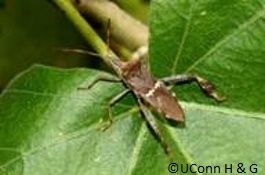
There are several leaf-footed bugs that live in Connecticut. They are members of the order, Hemiptera, and in the true bug family, Coreidae. Leaf-footed bugs get their name from the flattened, leaf-like flare on the lower portion of the back legs or tibia. They are brown with white marks on the margins of their folded wings. They closely resemble an insect that vegetable gardeners are familiar with, the squash bug. The most important economically is the Western conifer seed bug (Leptoglossus occidentalis). A relatively new pest, it was first identified in Connecticut in 1985. They are relatively large bugs, up to one inch in length. Other leaf-footed bugs can be grayish to black.
Leaf-footed bugs feed on the flower, cones and seeds of many species. They are known to do damage to nut trees such as almond and pistachio. The conifer seed bug does most of its damage in conifer seedling operations. They have a long sucking mouthpart that pierces the flowers or fruit. This damage causes misshapen, unmarketable nuts.
Adults emerge in spring and feed on flowers and newly forming seeds. Soon they mate and lay eggs on host trees. The eggs hatch after about 10 days and the nymphs start feeding. There are five nymph stages, called instars before adulthood. It’s this nymph feeding that causes the most economic damage. They are adults by August and continue to feed through the fall. They overwinter as adults in protected areas including your house. There is only one generation per year.
This nuisance insect invades homes in late summer and early fall looking for a warm crevice to spend the winter. They can fly but are most often seen walking on windows and walls. They do not injure houseplants or bite humans, though their large size and slow flight around the house can be startling.
Control
Control of leaf-footed bugs is not necessary. They are easy to catch because of their slowing metabolism. Once caught, they can be tossed outdoors to find somewhere else to stay for the winter. Be advised, these are members of the stink bug family. If held too long or crushed, they emit a foul odor.
Despite good cultural practices, pests and diseases at times may appear. Chemical control should be used only after all other methods have failed.
For pesticide information or other questions please call toll free: 877-486-6271.
Revised by UConn Home and Garden Education Center 2016.
Issued in furtherance of Cooperative Extension work, Acts of May 8 and June 30, 1914, in cooperation with the U.S. Department of Agriculture, the Dean of the College, Cooperative Extension System, University of Connecticut, Storrs. The Connecticut Cooperative Extension System is an equal opportunity employer and program provider. To file a complaint of discrimination, write USDA, Director, Office of Civil Rights, Room 326-W, Whitten Building, Stop Code 9410, 1400 Independence Avenue, SW, Washington, DC 20250-9410 or call (202) 720-5964.